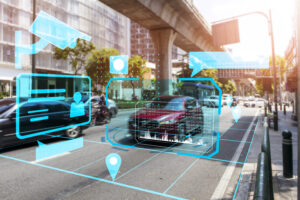AI models are only as reliable as the data they are trained on. While standard cases dominate most datasets, real-world deployments in autonomous mobility often stumble on edge cases—rare, unpredictable, or nuanced scenarios that defy easy categorization. A pedestrian partially occluded in a crosswalk, an unusual obstacle on a roadway, or a traffic sign under poor lighting conditions, all of these can undermine otherwise high-performing models. In healthcare, too, rare anomalies in scans present similar challenges.
Automated edge-case handling, combined with human expertise and continuous feedback loops, is key to bridging this gap. At iMerit, this process is not only supported by experienced annotators but also powered by Ango Hub, a platform designed to manage annotation validation, edge-case detection, and feedback workflows for complex edge-case data.
Why Edge Cases Matter
Edge cases are where AI reliability is tested, and where model performance is either validated or undermined. In autonomous mobility, these often involve traffic safety, such as pedestrians crossing unpredictably, unusual road layouts, or unexpected obstacles. In healthcare, edge cases can include rare conditions or ambiguous imaging data.
Automated tools are necessary for scale, but without human expertise and structured continuous feedback loops, edge-case detection remains incomplete. Edge cases are challenging because:
- Rarity: They appear infrequently, making them hard to anticipate.
- Ambiguity: Their interpretation often requires domain expertise.
- Impact: A single misclassification can have serious consequences.
This is why iMerit’s hybrid approach, pairing automation with expert human oversight, is essential. Unlike purely automated systems, which may overfit to common patterns, iMerit ensures that edge cases are surfaced, reviewed, and resolved with precision.
iMerit’s Hybrid Approach to Automated Edge-Case Handling
Automation accelerates the identification of anomalies within massive datasets, flagging images or data points that deviate from learned patterns. But automation alone is insufficient. Algorithms may detect that “something is off” without understanding what it means.
iMerit’s hybrid model, powered by Ango Hub, ensures rare, ambiguous, and high-impact events are not only detected but meaningfully resolved:
- Automated surfacing: Ango Hub’s pre-labeling and anomaly detection capabilities automatically flag potential edge cases.
- Human-in-the-loop expert annotation: Domain experts, whether radiologists, agricultural specialists, or AV engineers, interpret these cases with contextual knowledge. This HITL process ensures that automation is always grounded in real-world expertise.
- Iterative improvement & continuous feedback: Corrected edge cases are reintroduced into the dataset through continuous feedback loops, strengthening AI model robustness over time
In autonomous mobility, for example, AV engineers use the 3D Point Cloud Tool (3D PCT) to validate LiDAR and camera fusion, while annotators flag unusual scenarios such as occluded cyclists or emergency vehicles. This hybrid cycle transforms automated edge-case handling from a technical challenge into a competitive advantage for safer, more reliable AI systems.
Continuous Feedback Loops with Ango Hub
Edge-case handling is not a one-time event. Models evolve, environments shift, and new anomalies emerge. Continuous feedback loops are critical to maintaining accuracy and adaptability.
Ango Hub plays a central role in enabling these loops by:
- Feedback integration: Annotators can flag uncertain cases directly in the platform, creating a structured pipeline for expert review and annotation validation.
- Dynamic retraining: Corrected labels and annotations flow seamlessly into model retraining, ensuring AI model robustness is continually strengthened.
- Custom workflows: Teams can design validation steps specific to their domain, from medical scan review to autonomous vehicle sensor fusion.
This ongoing loop ensures that edge cases do not remain static challenges but become opportunities for models to learn and evolve.
Automated Quality Checks: First Line of Defense
Automation is invaluable in validating annotation quality at scale, especially for rare or complex mobility events. Ango Hub, combined with 3D Point Cloud Technology (3DPCT), integrates automated quality checks that enhance annotation validation:
- Cross-modal validation: 3DPCT compares LiDAR, camera, and radar sensor data to detect discrepancies and ensure accurate multi-sensor fusion.
- Spatial accuracy checks: It automatically verifies bounding box alignment, object dimensions, and distance measurements across 3D environments.
- Outlier detection: Flags statistical anomalies such as unusually shaped objects or missing point clusters that may represent mislabeled edge cases.
- Semantic consistency: Ensures that labels remain contextually accurate for example, differentiating between a bicycle on a rack versus one being ridden.
- Rule-based validation for mobility: 3DPCT enforces mobility-specific rules, such as lane boundary adherence, traffic sign placement, or pedestrian pathway alignment.

While these automated checks accelerate review, human-in-the-loop experts remain critical in resolving ambiguous mobility edge cases that algorithms cannot yet interpret correctly, such as rare traffic scenarios or weather-distorted sensor data.
Human Expertise in the Loop
Edge cases often involve subtle variations that require domain-level expertise. An AV safety engineer, for example, may understand why a LiDAR sensor misreads a reflective surface or why an occluded cyclist is misclassified by perception models. These insights are critical for edge-case detection and annotation validation.
Similarly, in healthcare, a pathologist may notice atypical cell morphology that automation misses, ensuring that critical diagnostic signals aren’t overlooked.
By combining this human judgment with platform automation, iMerit ensures that edge cases are handled with both speed and precision. This process enhances dataset reliability, minimizes model blind spots, and strengthens AI model robustness.
Business Impact: Why Edge-Case Handling Drives Robust AI
Managing edge cases is not just a technical necessity; it directly impacts the business value of AI deployments.
- Reliability in the field: For autonomous mobility, catching rare but high-risk events, like a LiDAR misread from reflective surfaces or a partially occluded cyclist, builds greater trust among regulators, riders, and OEM partners. In healthcare, ensuring pathologists can validate subtle anomalies builds physician trust in AI-assisted diagnostics.
- Reduced rework costs: Early edge-case identification prevents costly downstream corrections, whether it’s retraining an AV perception model after a safety incident or revisiting misclassified biopsy slides.
- Faster deployment: Robust datasets that capture rare scenarios shorten the gap between R&D and production-ready AI.
- Regulatory confidence: Strong annotation validation and edge-case detection demonstrate compliance and risk mitigation.
By embedding Ango Hub’s annotation-to-validation workflows, enterprises can operationalize automated edge-case handling while ensuring traceability and auditability.
Conclusion
Edge cases are where AI reliability is tested, and where model performance is either validated or undermined. Automated tools are necessary for scale, but without human expertise and structured continuous feedback loops, edge-case detection remains incomplete.
iMerit’s hybrid approach, powered by Ango Hub, ensures that rare, ambiguous, and high-impact events are not only detected but properly annotated, validated, and reintegrated into model training. With advanced mobility-focused tools like the 3D Point Cloud Tool, teams can efficiently handle complex perception data while Ango Hub orchestrates expert review and feedback. From pre-labeling automation to continuous feedback loops and validation, this integrated setup transforms automated edge-case handling into a competitive advantage.
For enterprises building AI in healthcare, autonomous mobility, or other high-stakes domains, this approach doesn’t just improve data quality; it strengthens AI model robustness, making systems more resilient, trustworthy, and ready for real-world deployment.

























